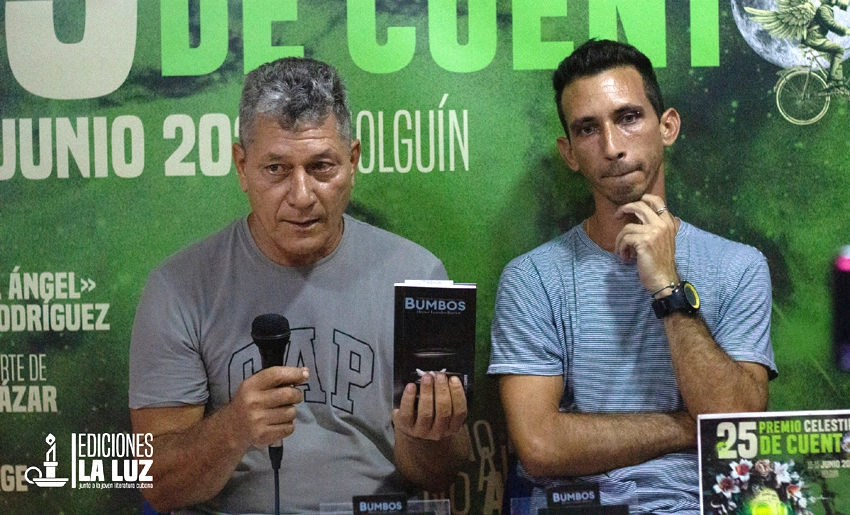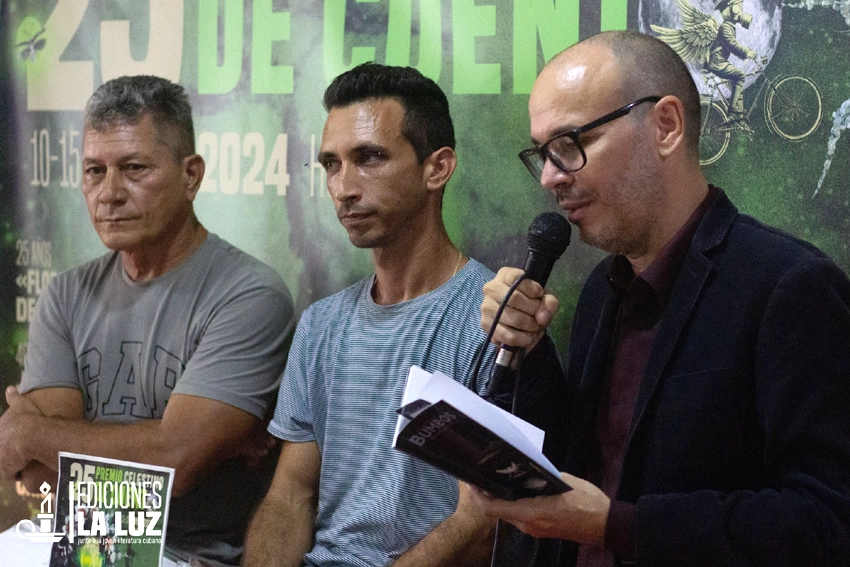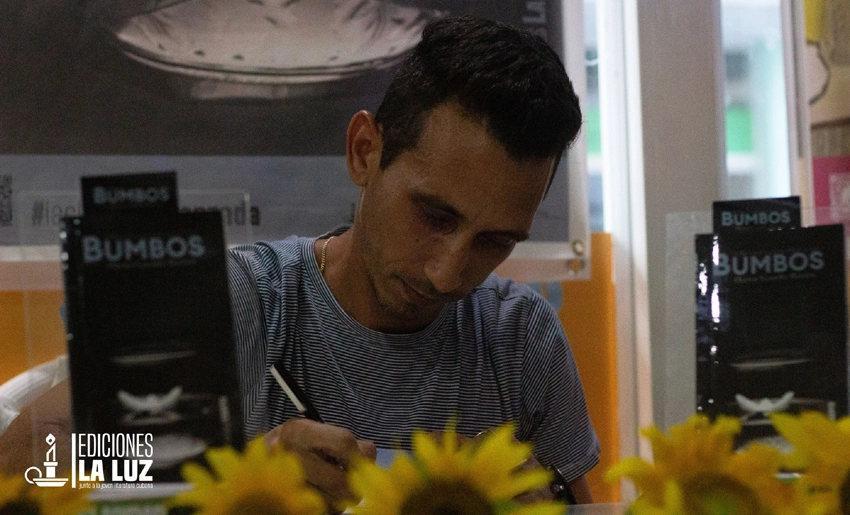Since the remote times of The Thousand and One Nights -Jorge Luis Borges rightly pointed out: “It is a book so vast that it is not necessary to have read it, since it is a prior part of our memory“- the short story, as a literary genre, never ceases to show its intimate belonging to the most indelible and profitable designs of civilization; the intertwined pleasure of telling and listening -that is, of writing and reading- a story, as many stories as possible, is essential for the knowledge of the human being and its circumstances.
The publication of the book Bumbos, by Hector Leandro Barrios (Rodas, Cienfuegos, 1985), winner of the 22nd edition of the Celestino Short Story Prize, confirms with energy the above mentioned.
These are eight fictions in which the charm of joyful telling and the power of knowing how to write them are intertwined, based on events that stand out, on natural and tenuous phrases in which something always happens: Telaraña, El último performance, Bulbo de luz, Bumbos, La morsa, Salto al vacío, De vuelta a casa, and Humo.
Cuban writers, book presentation

It is good to remember, in the shadow of this book, what a legendary maker, Julio Cortázar, said from his refined experience: “the storyteller knows (…) that his only resource is to work in depth (…) the time of the story and the space of the story have to be as if condensed, subjected to a high spiritual and formal pressure (…) Every lasting story is like the seed where the gigantic tree is sleeping. That tree will grow among us, will give its shadow in our memory”.
Thus, Bumbos places eight stories within the reader’s reach, with two inseparable conditions that accredit the author’s skill: on the one hand, the mastery of the technical requests that are indispensable at the time of narrating -breath, containment, curiosity, precision, surprise-, and on the other, the enunciation of the verbal requirements that are inherent to the way of employing a language – flow, usage, perception, certainty, tradition-. Both highlight the virtues of an apprenticeship.
What are the Bumbos about?
All of them expand on everyday life, on things that, not because they are within the reach of a glance, signify the expressiveness of situations and their protagonists, but rather what can be seen when, by digging into the surface of the facts, highlights a background in which people and environments, discover those lights and darknesses where human nature is revealed in its full extent, in a mosaic in which the storyteller spreads, with great tact, the warp of appearances and constraints.
Of course, each one of them distinguishes the ostensible of a well apprehended or closely followed narrative efficacy, ways of making the story a self-sufficient plot for the unraveling and enjoyment of instants that flow to the reader; however, there are three of them that are a splendid triptych that stands out by far: El último performance, Bulbo de luz, and Bumbos, and that last one, the jewel in Héctor Leandro’s crown, one of those narratives that seem to be written in the fullness of a rapture.
“Did you hear, they are setting up an exhibition in the hospital theater”. The interrogation is made to a young doctor who is finishing her specialty in cardiovascular surgery in Venezuela. The punch line is the opening of what is to come with The Last Performance, a question and answer that contain the keys to this sort of veiled suspense: “the artist is Cuban, Sonia is from Cienfuegos”. With well-tamed uneasiness unfolding step by step, the story heads safely toward the unexpected.
“…memory is moss, greenery that grows in the well of memories”. Such an assertion, at the beginning of Bulbo de luz, delineates a narrative that borders on the poem, an intimate journey through the twists and turns of childhood through a character who, like a timeless observer, breaks down the story: “A wooden house; Footsteps of the child; A hallway that smells of iodine; The afternoon, the sunset, the rain; Cardboard walls that do not reach the ceiling; The night, a nocturnality that embraces; Insomnia, visions; The ungraspable time; A distant night”….
“There I was, lying on the sofa in the living room, looking at the ribs of the ceiling or through the windows where the clouds whipped by a black whip were running”. Thus begins Bumbos, the author’s garment of excellence, as it has already been pointed out, and otherwise one of the most perfect stories of recent Cuban literature; the vestiges of a very high literary lineage gravitate in the writing of this piece -something that an alert reader distinguishes: Hemingway and Novas Calvo-, unique goldsmith’s enhancement.
Cuban Writers, Ediciones La Luz, Holguín

And that word, Bumbos, what does it mean… At the beginning it is specified that it is “a type of polymer boats or more exactly polymer structures similar to boats, but without keels. Structures that were also called corks, rafts. The rafts of anonymous fishermen, he said that time and I felt that his comment encouraged sparkles”. A story of apprenticeship based on the confidences of the novice fisherman, there is a scenario whose details unfold with subtlety, all of them inescapable.
A fragment of Bumbos that reveals the elegance of his prose and the depth of his gaze: “There was the fish, a huge fish, almost my size. A silver fish that Panfilo was trying to hang from a branch. It was beautiful! He was holding it up like a young prince, like the venerated corpse of a prince who would climb up to his catafalque (perhaps he was only exposing a war trophy to mockery). How many backs that cylindrical body would have twisted, how many fishing gear it would have mocked, how many notches of nickel-plated hooks”.
I have always believed that the most fortunate thing about a new storyteller, apart from the tasks he develops from his disposition, lies in the lineage that is highlighted in his texts -only attainable from, with, and through the passion of reading-. Hector Leandro carries on his back an arsenal of readings whose traces palpitate in the pieces of this book: Cardoso, Cortazar, Onetti, Pitol, Villoro… -just to mention a handful of names of the genre in our language that have an opportune descent-.
Thus, Bumbos is a happy discovery, a certainty of what the beautiful and unofficial Scheherezada crossed from the shadows of a remote room, to captivate her lover, and enlarge the horizons of the imagination until our days… Cortázar said: “The contemporary story is proposed as an infallible machine destined to comply with the maximum economy of means”. This is the lesson of Hector Leandro Barrios, that is, the infallible machine of a young storyteller.
- Maggie Mateo returns as a storyteller - 21 de May de 2025
- Farewell to Mario, Don Miguel’s disciple - 16 de April de 2025
- The savage detective and the unsubmissive translator - 7 de April de 2025

